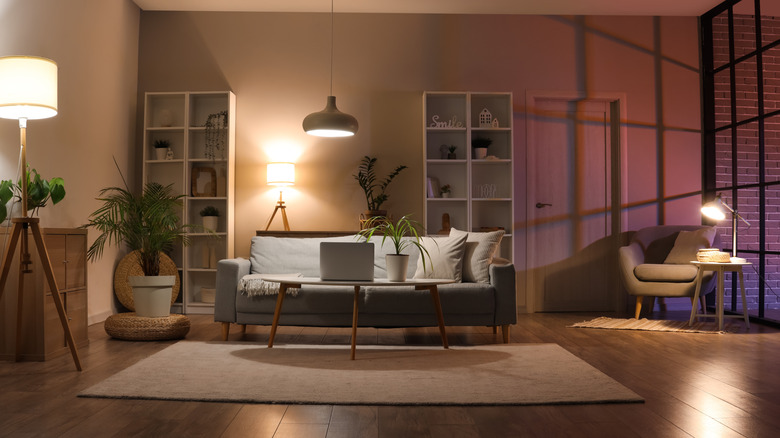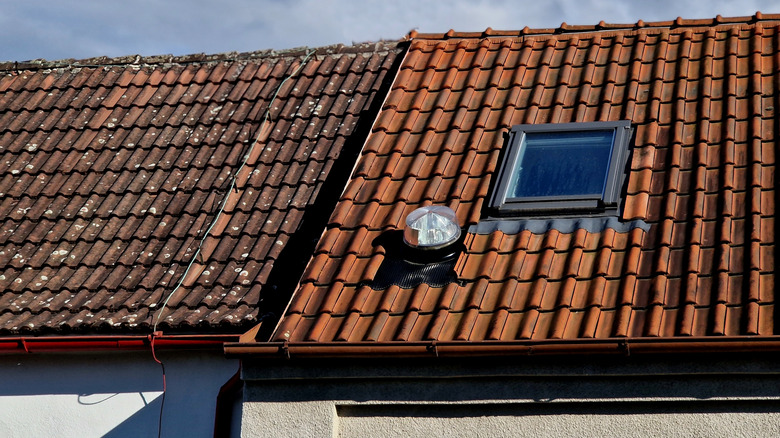The Cost-Effective Skylight Alternative That Brightens Any Gloomy Space
Much like plants, people need their light. That's why homeowners and investors are always looking for the best ways to improve natural light in their properties. The sun rays that sneak into a room make it brighter, warmer, larger, and more inviting. Conversely, there are actual health risks, psychological and physical, associated with spending too much time in artificially lit spaces. With windowless bedrooms and living rooms being absolutely inconceivable in architecture and interior design, more utilitarian, less leisurely areas like bathrooms, hallways, and closets are banished to the realm of darkness. But while skylights have long been seen as a solution to bring natural light into dark rooms, there is another more budget-friendly and easily installed option that's gaining steadfast popularity: sun tunnels.
As the name suggests, a sun tunnel provides a passage for sunlight from a roof-mounted dome or flat window, moving it through a highly reflective aluminum tube and into the home. They take less than a day to put in place, with labor and material costs amounting to less than half of a skylight installation. The result resembles a large recessed light with a diffuser covering the tube and protecting the room from the weather.
The many benefits of sun tunnels
Not only are sun tunnels a relatively inexpensive alternative to bring natural light into the gloomy corners of your home, they're also flexible enough to bypass awkward attics and obstructed roof structures without invasive construction work. If you have a particularly tricky place you want to light up, you can opt for a flexible tunnel instead of a rigid one or use elbows to dodge obstacles like beams or air conditioning units. Keep in mind that every time the light bounces off the tubing wall, it gets weaker by approximately 2%. This means that longer tunnels or tunnels with a lot of twists and turns will not be as effective as a short, direct tunnel. Even so, considering just how bright the light that comes in through a sun tunnel is, having a little less of it is still much better than none at all.
These structures are also customizable. They're available in different sizes, with the tunnels typically ranging from 10 to 21 inches wide and 5 to 10 feet long. You can make the diffuser round or square, its ring white or stainless steel, and its glass patterned or filtered to make the light warmer in tone. Some sun tunnels even have an available ventilation kit, an electric light kit, and a solar-powered accessory that will provide a dim light at night and possibly qualify you for the solar panel tax credit.
Are sun tunnels energy-efficient and weather-resistant?
The quality of the installation matters greatly when discussing the energy efficiency and weather safety of sun tunnels. Typically, the flashing is attached to the roof with a strong adhesive, then screwed and sealed. Weather-proof underlayment is then placed on top of the flashing before the roofing material is re-installed. Opting for a domed roof structure instead of a flat surface helps with water drainage and light absorption as well.
The immediate ecological and financial benefit of a sun tunnel is that you will no longer have to turn on the lights during the day, making it one of the best inexpensive products to consider to lower your energy bills. However, if you were worried that the direct sunlight could force you to turn on the air conditioning or bring out that old fan you had stored away, that's what the diffuser is for. This piece, which attaches to the ceiling to cover the tubing, helps spread the light and reduce glare. It's also sealed and double-paned for noise reduction and better weather control, just like a window.

